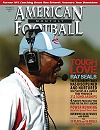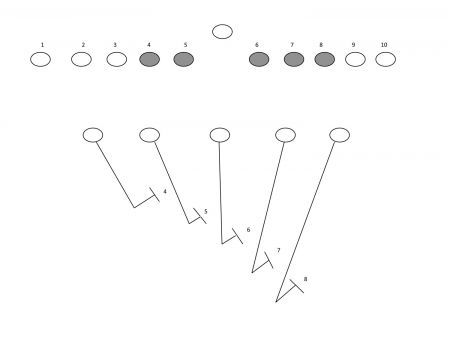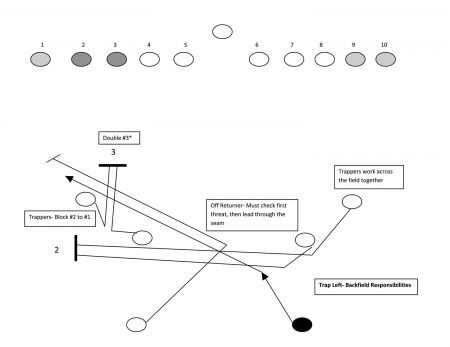Article CategoriesAFM Magazine
|
Making an Impact with Your Kickoff Returnby: Wendell SmithSpecial Teams Coordinator Ottawa University © More from this issue For a successful kickoff return, it is critical for all 11 players – including the deep returners – to think about making their block. There is almost nothing that compares to returning the opening kickoff of the season for a 95-yard touchdown against your school’s historic rival. The capacity crowd who had not yet made it to their seats for our 2010 opening game missed one of the most exciting moments of the year, a moment that made a statement to our opponent that we had come to win. That play was one of many exciting moments for our special teams units last season. It provided our staff with a great teaching tool by emphasizing the impact we can have on special teams. I have been blessed to work with three head coaches in my career that have truly understood the importance of special teams play. Supporting special teams play with adequate practice and meeting time is essential for success on the field. Our entire staff is involved in coaching our special teams units and every coach emphasizes the importance of special teams play on a daily basis. Our base return utilizes a man blocking scheme that I feel creates responsibility and ownership for our players. By specifically assigning eight members of the kickoff coverage team to members of our return team, we can quickly adjust and coach our players in both practice and games. Our return team understands that all ten players who do not have the ball in their hands must be responsible for blocking an opponent, starting with our returners. Our two deep men understand that they are asked to block first and return second. Our base return can be adjusted weekly based upon film study so that we can choose a point of attack on the opponent’s kickoff coverage team, or we can utilize a variety of similar returns that we already have in our special teams playbook. Our base return is a tried-and-true return that is closely related to what some consider an “off-tackle” or “trap” return. We like to overload the point of attack with a number of blockers, creating the potential for two double-team blocks, and opening a seam between the hash and the numbers on the field. This return begins with our front row of blockers matching up and blocking their assigned coverage man. For each of our returns, we count or number off the kickoff team 1-10, not counting the kicker, from the side of our called return. We like to sprint back and adjust our depth to the depth of the kick while gaining an angle to block defenders away from the point of attack (See Diagram 1).
Diagram 1: Trap Left – Front Row Responsibilities We coach our players to understand the timing of their block with the return—we do not want them to have to sustain a block for very long, and we want them to get in front of their man and accelerate their feet on contact. Our returner helps set up blocks by selling to the middle of the field before hitting the seam created by the trappers and double team blocks (See Diagram 2).
Diagram 2: Trap Left – Backfield/Returner Responsibilities In Diagram #3 there is a slight variation from the trap return that maintains our man blocking responsibilities and creates an “off-tackle” seam that we like to have for our returner. We create a double team with the playside guard and tackle of the front row, and we allow our wing to gain an angle on #5. Our backside wing looks for the first threat to the returner, possibly from a missed front row block. Our fullbacks look for #2 and #3 from the left, and our off-returner looks for the first threat before leading up the seam and looking for #1. As with our trap return, we can adjust blocking assignments from week to week, assigning certain coverage men to specific blockers or determining a weak point to attack on the coverage team.
Diagram 3: Brave Return Left Special teams plays account for a significant amount of “hidden yardage” in a game. If you look at college football statistics, special teams plays account for nearly 50% of total yardage and 25% of scoring on an annual basis. Many of the “biggest” plays in a game are punting and kickoff situations, and most psychological lifts and/or letdowns in football occur on special teams plays. If we force a team to squib or pooch kick to one of our wings or fullbacks, usually positioned between the 20 and 30 yard lines, we still have created decent field position. If the opponent opts to kick the ball out of bounds rather than to one of our deep returners, then we have accomplished our primary goal as a return unit. There has been a lot of discussion recently about eliminating the kickoff play from the game of football. As a special teams coordinator for the past ten years, my personal belief is that kickoff situations not only provide some of the most exciting plays in our game, but also require coaches to develop strategic plans that can change significantly from week to week. Although kickoffs have the potential to become hard-hitting plays, I believe that well-coached players who are taught to block and tackle with proper fundamentals do not have a greater risk of injury than on most other situations on the field. |
|
| HOME |
MAGAZINE |
SUBSCRIBE | ONLINE COLUMNISTS | COACHING VIDEOS |
Copyright 2024, AmericanFootballMonthly.com
All Rights Reserved







